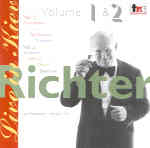Composer/conductor Virko Bailey has masterminded an extensive series of releases devoted to previously unissued concert recordings culled from Sviatoslav Richter’s concerts in Kiev. Volumes 1 and 2 feature material from 1958/59 recitals. While none of the repertoire is new to Richter’s immense discography, the pianist’s admirers will be interested to compare the Kiev performances to Richter’s other recorded versions. For starters, the Kiev Pictures at an Exhibition is captured in warmer, closer-miked sonics than the pianist’s better-known Sofia version (Philips) from the same year. His accelerandos in the opening promenade are slightly bumpy and unsettled in contrast to the organic flow of the Sofia and Prague readings, and Samuel Goldenberg and Schmuyle’s declamatory phrases are less fiercely inflected. Richter also plays Baba Yaga’s roaring octaves safer, whereas they roar with animal abandon in Sofia. On the other hand, the Chicks’ Ballet sports marginally cleaner execution, and the Old Castle is hypnotically drawn out and sustained.
The Mozart Sonata impresses for Richter’s supple passagework, ravishing tonal control, and centered yet never rigid rhythm–a far cry from the elder Richter’s more studied and stern 1989 live recording from the Barbican (Philips). Schumann’s Fantasia finds Richter on more spontaneous, lyrically inspired fettle than his relatively careful EMI studio traversal. In contrast to the steady gait of the pianist’s 1971 studio Rachmaninov G minor Prelude (Op. 23 No. 5), here Richter begins slowly and gathers steam as he progresses. On the other hand, the G-sharp minor Prelude (Op. 32 No. 10) is fleet from the start, perhaps a bit too brusque in relation to the breadth and poetry of numerous other Richter versions.
A tiny memory slip mars the beginning of Debussy’s Les collines d’Anacapri, but the Lydian-tinged Chopin C major Mazurka is more dynamically charged and subjective than the limpid, elegant one issued on BBC Legends. By contrast, there’s little to choose between the Praga Beethoven Op. 10 No. 3 and Op. 26 sonatas and the present ones of similar vintage, save for TNC’s marginally rounder and less grainy sound. I prefer the added clarity and concentration of Richter’s studio Op. 26 made for RCA in 1960, and better still, the further stylistic refinements of his wonderful mid-’60s live version issued in Philips’ Richter Edition. While this set adds little to what we already know of this great pianist’s formidable artistry, its finest moments are well worth the attention of Richter mavens. The overall sound quality is above average for non-professional, archival tapes of this vintage.
































